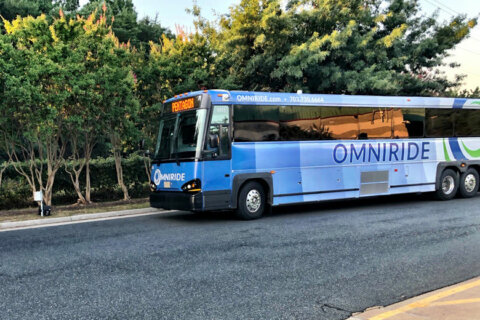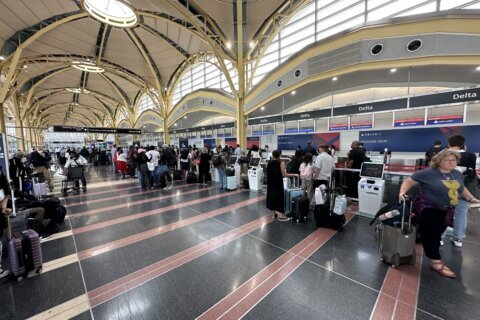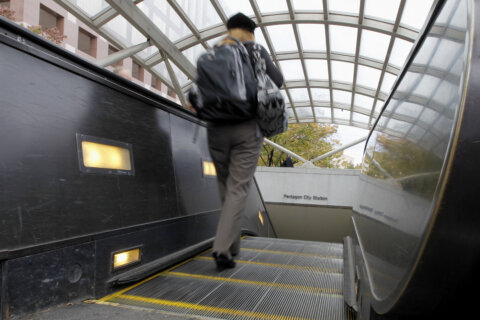WASHINGTON — Construction that will last four years is set to ramp up next month on new Interstate 66 toll lanes outside the Beltway.
The initial delays for drivers will be outside of rush hour on I-66 west of Va. Route 234 in Prince William County; between Jermantown Road and Va. Route 123 in Fairfax County; within the interchange at the Beltway; and along Va. Route 28.
Changes to remove Route 28 traffic signals near I-66 are one of the early pieces of the project scheduled to be completed, with changes expected to be finished by 2020.
The two toll lanes in each direction — along with three regular lanes and a permanent shoulder — will run 22 miles between the Beltway and Gainesville. They’re due to open by 2022.
The lanes — which will operate like the Interstate 495 Express Lanes on the Beltway — are being designed, built and operated by Express Mobility Partners. The group includes private companies such as Cintra, Meridiam, Ferrovial and Allan Myers. (The group does not include Transurban, which operates the I-95 and I-495 Express lanes.)
“Coming up in early March… [crews] will be setting out concrete barriers in some key high priority areas to shift traffic and then to have some work activities that will occur within existing right of way in some of these early, critical activity areas,” said Susan Shaw, Virginia Department of Transportation megaprojects director.
Crews are already implementing some rolling lane closures for soil boring and survey work.
Similar lane closures are scheduled for separate construction inside the Beltway on I-66 through the end of March. That work will add an eastbound lane to the 4-mile stretch between the Dulles Connector Road and Ballston; build a new bridge for the Washington & Old Dominion Trail; and add direct access from I-66 to the West Falls Church Metro. That project is due to be completed by 2021, with the additional lane open in late 2020.
Road construction will mean Metro shutdowns
The work outside the Beltway will lead to Metro shutdowns as well as delays on the roads.
“We just cannot have construction over our rail tracks while we’re running service,” Metro General Manager Paul Wiedefeld said. “You just cannot do it.”
The safety requirements mean Metro will need to shut down Orange Line service when toll lane construction is being done over the tracks at about five different locations, until enough work is done to fill in the flyover ramps to prevent anything from falling onto the tracks.
Plans to move a Metro power substation — to be paid for by the toll lane project — will also disrupt service.
Wiedefeld hopes to announce any planned disruptions during the four-year project well in advance. Metro and the companies building the lanes are in the process of scheduling work now.
Alternatives during construction
Metro, buses and other options still will be key to limiting traffic jams during toll lane construction, Shaw said.
A transportation management plan encourages more telework, incentivizes carpools and supports commuter bus routes.
“We try to do everything we can, recognizing that the choices are limited when it is a construction zone, and we know that that HOV lane is limited in its ability really to carry people, which is why we’re doing the project,” Shaw said.
Another early milestone required under the construction contract is a commuter park-and-ride lot off University Boulevard in Prince William County that is due to open in 2019.
“That’s so that we give people the opportunity to carpool in this corridor when we know it’s going to be essentially a work zone for the next four years,” Shaw said.
Negotiations continue with a property owner who will have to sell before the lot can be built.
Work outside the existing I-66 right of way is expected to begin later this year in the areas where the necessary property has been purchased or taken.
Construction is planned to be done simultaneously at several points along the corridor to meet the 2022 opening deadline, so drivers should expect to see work in multiple areas.
Design changes
While major design elements are getting final approvals, the details of some specific pieces continue to change even after final public hearings in November.
“The main focus of those hearings was to get the major design features approved. … The major features are working through final approval process,” Shaw said.
Other smaller details are still being tweaked.
Noise wall studies are expected to be complete by June. Neighborhoods that qualify for new noise walls would then get to vote on whether they should be put up.
“Generally speaking, we’re moving away from our large public information meetings and meetings are getting more focused on direct-impact communities … smaller groups,” Shaw said.







